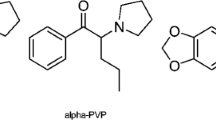Abstract
The purpose of the present study was to investigate the possible generalization to 3-carboxysalsolinol (3C-SAL) in a group of rats trained to discriminate a low dose of ethanol (200 mg/kg IP) from the nondrug condition and in another group trained to discriminate 0.16 mg/kg IP apomorphine (AP) from the nondrug condition using a drug discrimination paradigm. In test sessions, ED50 for ethanol was 52.0 mg/kg and ED50 for AP was 0.01 mg/kg. In the ethanol-trained rats, 1.8 mg/kg 3C-SAL produced drug responses. In the AP-trained rats, 200 mg/kg ethanol produced drug responses whereas 1.8 mg/kg 3C-SAL produced only a partial drug response. The results are in harmony with the hypothesis that salsolinol in the central nervous system of the rat may be responsible for the discriminability of ethanol. The possible involvement of dopaminergic systems is discussed.
Similar content being viewed by others
References
Barry, H., III: Classification of drugs according to their discriminable effects in rats. Fed. Proc. 33, 1814–1824 (1974).
Barry, H., III, Krimmer, E. C.: Discriminable stimuli produced by alcohol and other CNS depressants. In: Discriminative stimulus properties of drugs, H. Lal, ed., pp. 73–92. New York: Plenum 1977
Blum, K., Eubanks, J. D., Wallace, J. E., Schwertner, H., Morgan, W. W.: Possible role of tetrahydroisoquinoline alkaloids in post-alcohol intoxication states. Ann. N.Y. Acad. Sci. 273, 234–246 (1976)
Blum, K., Hamilton, M. G., Hirst, M., Wallace, J. E.: Putative role of isoquinoline alkaloids in alcoholism: A link to opiates. Alcoholism: Clin. Experimental Res. 2, 113–120 (1978)
Brossi, A., Focella, A., Teitel, S.: Alkaloids in mammalian tissues. Condensation of l-dopa and its two mono-O-methyl esters with formaldehyde and acetaldehyde. Helv. Chimica Acta 55, 15–21 (1972)
Church, A. C., Fuller, J. L., Dubek, B. C.: Salsolinol differentially affects mice selected for sensitivity to alcohol. Psychopharmacology 47, 49–52 (1976)
Collins, M. A., Bigdelli, M. G.: Tetrahydroisoquinolines in vivo. Rat brain formation of salsolinol, a condensation product of dopamine and acetaldehyde under certain conditions during ethanol intoxication. Life Sci. 16, 585–602 (1975)
Collins, M. A., Hannigan, J., Weiner, C. D.: Tetrahydroisoquinoline (TIQ's) from alcohol-derived aldehydes: Selective effects on brain dopamine following peripheral administration. Alcoholism 2, 192–198 (1978)
Colpaert, F. C., Leysen, J. E. M. F., Niemegeers, C. J. E., Janssen, P. A. J.: Blockade of apomorphine's discriminative stimulus properties: Relation to neuroleptic activity in neuropharmacological and biochemical assays. Pharmacol. Biochem. Behav. 5, 671–679 (1976)
Colpaert, F. C., Niemegeers, C. J. E., Kuyps, J. J. M. D., Janssen, P. A. J.: Apomorphine as a discriminative stimulus and its antagonism by haloperidol. Eur. J. Pharmacol 32, 383–386 (1975)
Conger, J. J.: The effects of alcohol on conflict behavior in the albino rats. Q. J. Stud. Alcohol 12, 1–29 (1951)
Costall, B., Naylor, R. J., Pinder, R. M.: Hyperactivity induced by tetrahydroisoquinoline derivatives injected into the nucleus accumbens. Eur. J. Pharmacol. 39, 153–160 (1976)
Heikkila, R., Cohen, G., Dembrec, D.: Tetrahydroisoquinoline alkaloids: Uptake by rat brain homogenates and inhibition of catecholamine uptake. J. Pharmacol. Exp. Ther. 179, 250–258 (1971)
Litchfield, J. T., Wilcoxon, F.: A simplified method for evaluating dose-effect experiments. J. Pharmacol. Exp. Ther. 96, 99–113 (1949)
Marshall, A., Hirst, M.: Potentation of ethanol narcosis by dopamine- and l-dopa-based isoquinolines. Experimentia 32, 201–203 (1976)
Melchoir, C. L., Myers, R. D.: Preference for alcohol evoked by tetrahydropapaveroline (THP) chronically infused in the cerebral ventricle of the rat. Pharmacol. Biochem. Behav. 7, 19–35 (1977)
Melchoir, C. L., Simpson, C. W., Myers, R. D.: Dopamine release within forebrain sites perfused with tetrahydroisoquinolines or tryptoline in the rat. Br. Res. Bull. 3, 631–634 (1978)
Myers, R. D., Melchoir, C. L.: Alcohol drinking: Abnormal intake cause by tetrahydropapaveroline (THP) in brain. Science 156, 554–556 (1977)
Myers, R. D., Melchoir, C. L.: Differential actions on voluntary alcohol intake of tetrahydroisoquinolines or a β-carboline infused chronically in the ventricle of the rat. Pharmacol. Biochem. Behav. 7, 381–392 (1978)
Nijm, W. P., Riggins, R., Teas, G., Kissinger, P. T., Borge, G. F., Collins, M. A.: Urinary dopamine-related tetrahydroisoquinolines: Studies of alcoholics and nonalcoholics. Fed. Proc. 36, 334 (1977)
Overton, D. A.: Experimental methods for the study of state-dependent learning. Fed. Proc. 33, 1800–1813 (1974)
Ross, D. H., Medina, M. A., Cardenas, H. L.: Selective depletion of regional brain calcium. Science 186, 63–65 (1974)
Sandler, M., Carter, S. B., Hunter, K. R., Stein, G. M.: Tetrahydroisoquinoline alkaloids: in vivo metabolites of l-dopa in man. Nature 241, 439–443 (1973)
Seeman, P., Lee, T.: The dopamine-releasing actions of neuroleptics and ethanol. J. Pharmacol. Exp. Ther. 190, 131–140 (1974)
Sheppard, H., Burghardt, C. R.: Effect of tetrahydroisoquinoline derivatives on the adenylate cyclases of the caudate nucleus (dopamine-type) and erythrocyte (β-type) of the rat. Res. Commun. Chem. Pathol. Pharmacol. 8, 527–534 (1974)
Siegel, S.: Nonparametric statistics for the behavioral sciences. New York: McGraw Hill 1956
Truitt, E. B., Jr.: Ethanol induced release of acetaldehyde from blood and its effect on determination of acetaldehyde. Q. J. Stud. Alcohol 31, 1–12 (1970)
Wajda, I. J., Manigault, I., Hudick, J. P.: Dopamine levels in the striatum and the effect of alcohol and reserpine. Biochem. Pharmacol. 26, 653–655 (1977)
York, J. L.: A comparison of the discriminative stimulus effects of ethanol, barbital and phenobarbital in rats. Psychopharmacology 60, 19–23 (1978)
Author information
Authors and Affiliations
Rights and permissions
About this article
Cite this article
Schechter, M.D. Ability of 3-carboxysalsolinol to produce ethanol-like discrimination in rats. Psychopharmacology 68, 277–281 (1980). https://doi.org/10.1007/BF00428115
Received:
Accepted:
Issue Date:
DOI: https://doi.org/10.1007/BF00428115




